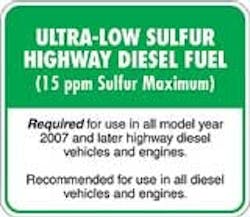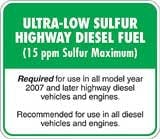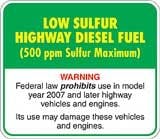Ultra-Low Sulfur Diesel Fuel Cleans Up Heavy Duty Exhaust
EPA required a 97-percent reduction in the sulfur content of highway diesel fuel from its pre-2007 maximum of 500 parts per million (low sulfur diesel, or LSD) to 15 parts per million (ultra low sulfur diesel, or ULSD). Refiners began producing cleaner-burning ULSD for use in highway vehicles beginning June 1, 2006. (Rule can be found in the Federal Record at 40 CFR Part 80.) It takes about 60 trucks with 2007-emissions-compliant engines to equal the particulate emissions of just one truck sold in 1988.
Once this rule is fully implemented, 2.6 million tons of smog-causing nitrogen oxide emissions will be reduced each year. Soot or particulate matter will be reduced by 110,000 tons a year. An estimated 8,300 premature deaths, 5,500 cases of chronic bronchitis and 17,600 cases of acute bronchitis in children will also be prevented annually.
By 2010, most diesel engines will have to burn ULSD. But for now, clean-air rules only require use of the clean diesel in engines manufactured for the 2007 model year and after. The rule also requires 80 percent of diesel produced in the United States be ULSD, though, so it is changing the way diesel fuel is burned in today's vehicles — from Class 8 trucks to pickup trucks, and from scrapers to SUVs.
The fuel change is necessary for 2007 on-road diesels to meet the Environmental Protection Agency's (EPA's) 2007 emissions limits. Exhaust aftertreatment devices — particulate filters and NOx catalysts plumbed into the exhaust line — were designed to work with ULSD. Operating without the clean fuel, these expensive devices are quickly ruined, engine reliability and fuel economy will suffer, and the engine warranty will be voided. Anyone responsible for fueling a 2007 model year engine with diesel that has more than 15 ppm sulfur is subject to civil prosecution and fines.
The previous on-road fuel, LSD with sulfur content up to 500 ppm, won't be gone completely for several years. Diesel engines from the '06 model year and earlier and what EPA calls non-road diesels — off-road engines in everything except locomotives and boats —may be fueled with LSD until 2010. Locomotive and marine diesels make the transition to ULSD in 2012. California kept it simple. Since Sept. 1, 2006, the only diesel available in the state has been ULSD. There are a lot of pre-2007 engines burning ULSD.
Before there was broad-based use of the new fuel, industry speculation suggested that there might be a very limited reprise of fuel-system problems experienced at the introduction of LSD in 1993. Removing some sulfur from diesel fuel 14 years ago caused some older seals to fail and systems leaked. LSD also has some solvent properties, which loosened deposits in older fuel systems and caused premature filter plugging.
History is reason enough to keep a close eye on fuel systems of the oldest engines if they are, indeed, switched to a lower-sulfur diet. Watch most carefully those non-road engines built before 1993 that had been fueled with non-road fuel containing more than 500 ppm sulfur. Virtually all fuel systems built since 1993 use upgraded seals that aren't as susceptible to fuel changes.
"In the Chicago area, we started using ULSD probably mid-summer last year and we didn't see any issues related to its use," says Joe Fell, fleet manager with Ryan Central, of the Janesville, Wis., contractor's mostly off-road diesel fleet.
For on-road engines, there's plenty of reason to expect a problem-free transition to ULSD. Their seals have been upgraded as non-road fuel systems have. With LSD sulfur limited to 500 ppm, the switch to ULSD at less than 15 ppm sulfur represents a less-dramatic change than in 1993.
Many municipal and transit fleets in regions with serious air-quality issues, such as parts of New York and California, have been operating pre-2007 diesel vehicles for some time on ULSD. Nationwide, major trucking concerns such as Penske and Ryder started testing ULSD well before California's early transition. They reported no reliability problems.
The truckers' razor-sharp focus on fuel costs measured less than a 1-percent fuel-economy decline in '06 or older trucks burning ULSD, even though cleaning up the fuel can reduce its energy content slightly.
"Additive packages are more important in ULSD," says Fell. "They're engineered to go above and beyond the specs — to help the fuel atomize finer, which makes it burn cleaner and improves efficiency."
Only ultra low sulfur kerosene (No. 1 diesel with no more than 15 ppm sulfur) is allowed to be blended with ULSD fuel to improve cold-weather performance. Blend rates will remain the same as with LSD fuel. Most engine and vehicle manufacturers allow biodiesel blends in concentrations up to 5 percent provided those blends meet ASTM quality standards. For use in 2007 engines, biodiesel will have to be blended with ULSD.
Experience in California since September confirms that there are no immediate reliability issues to fear from clean diesel.
"To our surprise, the transition seemed to have gone almost seamlessly," says Tupper Hull, a spokesman for the Western States Petroleum Assn., which represents the petroleum industry in California, Washington, Oregon, Nevada and Arizona. "We anticipated there might be some fuel leakage and, in fact, Chevron had a bulletin out that identified some potential for fuel-system leaking. But we have not received any significant complaints."
Preserving the extremely low sulfur content of ULSD despite the opportunities for contamination in the distribution channel presents a real challenge to refiners and distributors. Mixing a very small portion of diesel at 500 ppm sulfur will render a bulk tank or pipeline full of ULSD illegal and destructive if used in 2007 truck engines.
Fleets planning to fuel their own 2007 engines should take steps to make sure the ULSD pumped into their storage tanks isn't contaminated by residual low-sulfur fuel. Private fueling operations will be able to downgrade 20 percent of the ULSD delivered to them each year if it is contaminated with a higher-sulfur fuel. But they won't be able to use that fuel in 2007 truck engines.
Switching a LSD tank to handle ULSD requires a little preparation. Three or four product turns, or refills, with the new fuel should flush enough sulfur out of a tank that the fuel can be safely used in 2007 engines. Test the fuel coming out of converted tanks to be certain sulfur content is at or below 15 ppm before using the ULSD in new trucks.
Diesel pumps must be labeled to indicate the type of fuel on tap. Refueling operations are also required to archive product transfer documents for a five-year period. The federal fine for dispensing fuel as ULSD that does not meet the spec is $32,500 per day per incident for a minimum of 25 days.
In regions farthest from refineries, fuel must pass through multiple distribution points and the risk of contamination before it reaches the buyer is highest. For the next few months, users of 2007 on-road diesels in remote places may have to take special care to be sure they can get ULSD. If the price difference between ULSD and low-sulfur diesel grows much beyond 13 cents per gallon, retailers in some pockets of the country may choose to keep only low-sulfur fuel in inventory.
The industry has been expecting ULSD to cost about 4 cents per gallon more than LSD, but volatility in the fuel market has made the price difference difficult to identify. As of Jan. 18, national-average retail prices for on-highway diesel had dropped for three consecutive weeks.
When California made the complete transition to ULSD in September, there was no spike in diesel prices, according to data compiled by the Oil Price Information Service (OPIS), a third-party research firm that tracks daily fuel prices. But when gasoline prices dropped last Labor Day and diesel prices remained stable, some observers argued it was because of refiners' prodigious investments to produce ULSD.
It's important to remember that refiners invested billions of dollars to produce ULSD. They're going to make that investment pay. Contract price on a barrel of crude oil on Jan. 12 was $50.12, which was $6.63 per barrel less than the price a year ago. Nevertheless, the retail price per gallon of on-highway diesel fuel was $2.46, which was about 1.5 cents per gallon more than one year ago. (See the Energy Information Administration’s “This Week in Petroleum,” January 18, 2007)
Despite a diesel pump price that's 24 cents per gallon higher than gas, ULSD and aftertreatment technologies appear to be encouraging automakers to develop diesel engines for light trucks, SUVs, vans and cars. About half of European light vehicles sold today are diesel fueled because of the engine's power, durability, and fuel economy — typically 20 to 30 percent more efficient than conventional gasoline engines.
J.D. Power Automotive Forecasting expects the U.S. market for light-duty diesel engines to grow from 3.6 percent in 2006, or about 600,000 vehicles, to about 9 percent in 2013, or 1.66 million vehicles. By 2015, they project diesels will have a 12 percent market share, or 2.2 million vehicles.
Volkswagen and DaimlerChrysler have announced plans to introduce diesel models that will meet emissions standards in all 50 states by 2008. DaimlerChrysler has signed an agreement to buy light-duty diesel engines from Cummins for use in vehicles with GVW of less than 8,500 pounds. Cummins will build the new line of light-duty diesels in its Columbus plant. Production is scheduled to begin by 2010.
Ford plans to offer a diesel version of its popular F-150 pickup, and General Motors says it will bring diesel to light-duty pickups after 2009. Honda Motor Co. has said it will introduce a diesel vehicle within three years that will meet California's emissions standards.
Two weeks into the national transition to ULSD, it appeared that the rest of the country was enjoying a fuel non-event much like the problem-free California experience. A downside to the switch to ULSD has yet to appear, and use of diesel seems likely to expand significantly.


